
The village constable’s staff of office made in 1804 is just 7in (18cm) long. It was found in the thatched roof of a Staffordshire farm by a child when the building near Lichfield was demolished in the 1960s, according to Hansons Auctioneers of Etwall, Derbyshire.
Known as a tipstaff and adorned with a crown carrying the insignia of George III, it was an object of authority used 25 years before the Metropolitan Police Act established the first British formal police force under Sir Robert Peel. Met officers – popularly known as ‘Bobbies’ or ‘Peelers’ - patrolled with 20in (51cm) wooden truncheons, but could resort to 50 flintlock pistols for use in exceptional circumstances.
The example on offer at Hansons would be more suitable for a tap on the shoulder than the whack a truncheon as we understand it today can deliver, but this tipstaff would have been a ceremonial object anyway and not used in the line of duty.
“Larger truncheons came in with the passing of the County Police Act in 1839, which enabled a Justice of the Peace to form police forces within their counties for the preservation of the order and the protection of their inhabitants,” said Hansons owner Charles Hanson.
“The very early truncheons, from Brighton and Doncaster, were decorated with bright gilt and enamel on a black ground, with Victorian arms within a garter and inscriptions. Truncheons of the Victorian period were often 15-18in [38-45.5cm] long.”
The tipstaff “spent some time on display in a small country museum” before being consigned top auction. It is estimated at £200-300.





